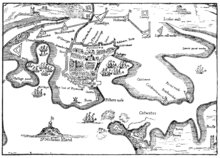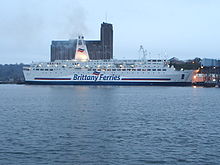- Millbay
-
Coordinates: 50°22′05″N 4°08′53″W / 50.368°N 4.148°W Millbay, also known as Millbay Docks, is an area of dockland in Plymouth, Devon, England. It lies south of Union Street, between West Hoe in the east and Stonehouse in the west.
A panorama of Millbay, showing at the right, the Brittany Ferries port with MV Pont-Aven in the dock.
Contents
Early history
Mill Bay was a natural inlet to the west of the Hoe. It was originally far more extensive than the current docks because it included the "Sourepool" which was a tidal salt-marsh that lay roughly along the line of today's Union Street. The Sourepool was separated from the bay by a narrow neck across which tidal mills were built, probably in the 12th century. These mills were operated by the Priors of Plympton who collected the income from grinding corn. By the mid 15th century, the mills were owned and let by the Corporation of Plymouth; the lease was sold to Francis Drake in 1573. In 1591-2 Drake built six new mills along Drake's Leat that had recently been completed. Around this time the old tidal mills closed and the Sourepool was drained ("made drie for a meadow") in 1592.[1]
During the English Civil War, Plymouth declared for Parliament and was the subject of a prolonged Royalist siege between 1642 and 1646. At this time Millbay was the only harbour of Plymouth that was out of reach of the Royalist artillery so it became the sole source of resupply for the town. From the end of the Civil War Millbay reverted to a quiet anchorage with no jetties or port facilities, but in 1756 John Smeaton built a jetty and workyard in the south west corner of the harbour for unloading and working the stone for the third Eddystone Lighthouse. A ten-ton ship, named the Eddystone Boat, was based here and took the worked stones out to the reef.[2]
Smeaton's lighthouse was completed in 1759 and around this time the Long Room (an assembly room), bath house, bowling green and other amenities were built nearby.[1] Of these, only the Long Room survives, built in red brick with Portland stone facings. To its north the Royal Marine Barracks, Stonehouse were built, 1779 – 85.[3] Until Victorian speculators constructed new docks and warehousing, this had a watergate into Millbay from which the navy's soldiers embarked for service at sea.[citation needed]
19th century expansion
“ Before the Great Britain made her appearance, the Severn, Cork steam-vessel, took on board from Gill's Military Pier a large party, and went out to meet her … The Severn followed the Great Britain into Millbay, firing salutes at intervals. ” —Exeter Flying Post, 19 June 1845.[2]
A map from the late 1830s shows a small "Union Dock" at Millbay, about which not much is known, but in 1840 an Act of Parliament granted Thomas Gill the authority to build a pier and other works at the mouth of Millbay as well as deepening the creek. Gill had a quarry at the east side of the harbour, and the pier he built, now known as Millbay Pier, was 500 feet (150 m) long and was completed in 1844. The following year the SS Great Britain berthed here during her maiden voyage to New York and was visited by 15,000 sightseers.[2]
In 1846 another Act of Parliament established the Great Western Dock Company to provide full facilities for shipping at Millbay. Gill sold his Millbay Pier to this company and became a director. Isambard Kingdom Brunel was engaged to design new docks; both he and Gill were involved in the South Devon Railway, so it is no surprise that the first railway station in Plymouth was opened nearby in 1849. The next year a railway extension was built to the new docks, customs facilities were granted and the docks were recognised as a Government mail packet station.[2]
Brunel next built another pier, an iron floating pontoon 300 ft (91 m) long by 40 ft (12 m) wide (91 m × 12 m) for the Irish Steamship Company whose vessels were regularly using the harbour. Then he constructed the inner basin, with limestone and granite walls. It had dock gates and a drydock at the western side and was 1,250 by 400 feet (380 by 120 m) in size. It opened in 1857. Part of the earth dam that had been built across the harbour to facilitate the creation of the inner basin was retained for the later construction of Trinity Pier. From then on a few modifications were made, but no major changes took place until the construction of the ferry terminal in the 1970s.[2]
Millbay was a busy commercial dock because it could accommodate larger ships than Sutton Pool, off the Cattewater. A wide range of freight was handled, with grain always being an important import. It was also one of the major coaling stations in the English Channel. A significant amount of shipbuilding took place here: Willoughby Bros Ltd., for example, was in business from 1857 until 1969 and built vessels for the Royal Mail Steamship Company, Customs and Excise and others, as well as chain ferries for Torpoint, Saltash, Littlehampton and Felixstowe.[2]
Ocean liner traffic
From the 1870s until the Second World War Millbay was a busy landing point for rich travellers from the USA who preferred to disembark the transatlantic liners in Plymouth Sound, come ashore in tenders and catch fast trains from Millbay station to London Paddington, thereby substantially reducing travel time by avoiding the sea passage to Southampton or Tilbury. It was known as "the route which cuts the corners off".[2] An idea of the scale of this business can be seen from the fact that during the 20th century over six million passengers landed or were embarked from Millbay and as many as 800 passengers would come ashore from one liner.[4] The peak year for liner traffic was 1930, when 788 liner calls were made to Plymouth.[2] Millions of mailbags were handled too.[4]
The railway company quickly became aware of the benefits of this traffic and took the initiative in ordering the first of a series of steamers, the Sir Francis Drake (173 tons), delivered in 1873. It was quickly followed by the smaller Sir Walter Raleigh and in 1883 by the Palmerston and the Smeaton. Many others followed, culminating in the Sir John Hawkins which replaced the ageing Smeaton in 1929. The Sir John Hawkins was 939 tons and was capable of about 14 knots (26 km/h).[2]
On Sunday, 28 April 1912 the majority of the surviving crew of the RMS Titanic disaster disembarked here in secrecy. They were then taken by train from Millbay station to Southampton.[2]
Today
There are currently two large deepwater docks, one of which is part-owned by Brittany Ferries, which has its UK headquarters here. Since 1973 the company has operated ferry services from the dock to Roscoff on the north coast of Brittany, France, and also to Santander on the north coast of Spain. Ferry services depart and arrive daily from March to late October, and less regularly during the winter months.
MV Pont L'Abbe at Millbay in 2006. The (now demolished) grain silo is in the background.
The dock was expanded in 2003 to accommodate Brittany Ferries' new 40,000 ton flagship Pont-Aven, and the terminal building was also renovated. The Pont-Aven shares the dock with the new Armorique, the replacement for the Pont L'Abbe. During the winter months, the Bretagne, usually assigned to Portsmouth, sometimes visits Millbay. During February 2008, the Brittany Ferries fastcraft Normandie Express visited Millbay, the first time that a high speed craft had been used out of Millbay.
Millbay is the home of the Plymouth RNLI All-Weather and Inshore Lifeboats, as it has been since 1862. The landmark which most Plymothians remember as the easiest way of locating the entrance to this harbour,[citation needed] a huge boxlike grey concrete grain silo with a substantial tower was demolished in early 2008.[5]
The area is being targeted as a key area for regeneration in Plymouth[6][7] as a part of the multi-agency Plymouth redevelopment plan.
The large area inside the road linking the Duke of Cornwall Hotel along the dock wall to the Royal Marine Barracks, and then North and back along Union Street has been Plymouth's busiest and notorious red light district for more than a century.
References
- ^ a b "Millbay Docks 150 Exhibition - Mill Bay, Lighthouse and Long Room, Ships and Soldiers". www.plymouth.gov.uk. http://www.plymouth.gov.uk/millbay_docks_1-5.pdf. Retrieved 2008-03-07.
- ^ a b c d e f g h i j Langley, Martin (1987). Millbay Docks (Port of Plymouth series). Exeter: Devon Books. ISBN 0-86114-806-1.
- ^ Bridget Cherry & Nikolaus Pevsner (1989). The Buildings of England — Devon. Harmondsworth [Eng.]: Penguin. p. 655. ISBN 0 14 071050 7.
- ^ a b Gill, Crispin (1994). "Ocean Liners at Plymouth". In Michael Duffy et al.. The New Maritime History of Devon Volume 2. From the late eighteenth century to the present day. London: Conway Maritime Press. pp. 226–228. ISBN 0-85177-633-7.
- ^ "BBC - Devon - Features - 'Rats the size of cats'". www.bbc.co.uk. http://www.bbc.co.uk/devon/content/articles/2008/02/08/millbay_silo_feature.shtml. Retrieved 2008-03-07.
- ^ "Millbay, Plymouth". www.englishpartnerships.co.uk. http://www.englishpartnerships.co.uk/millbay.htm. Retrieved 2008-03-07.
- ^ "Millbay, Plymouth's Coastal Quarter". www.millbayplymouth.com. http://www.millbayplymouth.com. Retrieved 2008-10-11.
Categories:- Plymouth, Devon
- Ports and harbours of the English Channel
- Ports and harbours of Devon
Wikimedia Foundation. 2010.




